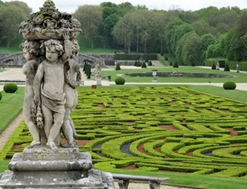Located in the West of Paris, in the town of Versailles, France, the Versailles Palace was the royal residence of Louis XIV, Louis XV and Louis XVI. It has become the symbol of French royalty’s splendour.
Localizado no Oeste de Paris, na cidade de Versalhes, na França, o Palácio de Versailles foi a residência real de Luís XIV, Luís XV e Luís XVI. Tornou-se o símbolo do esplendor da realeza francesa.
How to get there by train: RER C – To get to the palace of Versailles, make sure to buy a "Paris – Versailles Rive Gauche" ticket.
Royal residence during the 12th and 13th century, the Château de Vincennes kept its surrounding wall, medieval towers, and the 14th century donjon, the Sainte-Chapelle and the 16th century stained glass windows.
Residência real durante a XII e século XIII, o Château de Vincennes manteve a sua muralha circundante, torres medievais, bem como a torre de menagem do século XIV, a Sainte-Chapelle e os vitrais do século XVI.
How to get there by train: metro line 1 – Château de Vincennes or RER A – Vincennes station
Located 50 km South-East of Paris, the Chateau de Vaux Le Vicomte is a baroque style castle from the XVIIth century. Nicolas Fouquet commissioned the best artists of the time to build his castle: the architect Louis le Vau, the painter Charles le Brun and the landscape gardener André Le Nôtre.
Situado a 50 km sudeste de Paris, o Château de Vaux Le Vicomte é um castelo barroco do século XVII. Nicolas Fouquet encarregou os melhores artistas da época para construir seu castelo: o arquitecto Louis Le Vau, o pintor Charles Le Brun e ainda o paisagista André Le Nôtre.
How to get there by train: From Gare de Lyon in Paris take the direct train (25 minutes) to the station of Melun and from there to the chateau – 6 km by taxi or with the Chateaubus shuttle.
This XIVth century castle housed over the centuries many famous figures that gradually transformed it into a charming residence acquired by Louis XVI in 1783.
Este castelo do séc. XIV abrigou ao longo dos séculos várias personagens ilustres que progressivamente o transformaram numa residência de charme adquirida por Louis XVI em 1783.
How to get there by train: From Gare Montparnasse take the train in direction to Chartres till Rambouillet, then 18mn on foot.
Seven centuries of French royal history spin around this castle in the town of Fontainebleau, 60km south of Paris. Surrounded by a superb forest, Fontainebleau is more intimate than Versailles and a product of the Renaissance movement in France in the 16th century.
Sete séculos de história giram em torno deste castelo na cidade de Fontainebleau, 60 km a sul de Paris. Cercado por uma floresta magnífica, Fontainebleau é mais íntimo do que Versalhes e um produto do movimento da Renascimento na França no século XVI.
How to get there by train: From the Gare de Lyon (main line), take the train for either Montargis Sens or Montereau, alighting at Fontainebleau-Avon station, then take the ‘Ligne A’ bus destined for Les Lilas, alighting at the ‘Château’ stop.
For the first time last October, the castle hosted a video clip shooting. For 3 days, it was the setting for the video "Born To Die" from Lana Del Rey.
This Renaissance-style chateau formerly owned by Le Grand Condé, a cousin of Louis XIV, was originally built in the sixteenth century. Although most of it was destroyed during the French Revolution, it was subsequently rebuilt in the 1870s.
Este castelo de estilo renascentista anteriormente detido por Le Grand Condé, um primo de Luís XIV, foi originalmente construído no século XVI. Embora a maior parte tenha sido destruída durante a Revolução Francesa, foi posteriormente reconstruído na década de 1870.
How to get there by train: From the Gare du Nord SNCF Grandes lignes to Chantilly and then Le DUC (Chantilly’s town free bus): departure from the bus station (at SNCF railheads), alight at the "Chantilly, église Notre-Dame" stop.
The Chateau de Compiegne that we can see today is a French castle that was designed by the architect Ange-Jacques Gabriel as a royal residence for King Louis XV and was started in 1751 yet finished by the architects student, Le Dreux de La Chatre in 1788.
O Chateau de Compiègne que podemos ver hoje foi projetado pelo arquiteto Ange-Jacques Gabriel como uma residência real para o rei Luís XV e foi iniciado em 1751 e concluído pelo arquiteto Le Dreux de La Chatre em 1788, seu aluno.
How to get there by train: Train from La Gare du Nord (45min)
all images via Google























Beautiful selection, have popped it on my Pinterest board for others to enjoy
Thanks for this list.. I think I’ve been to most of them now!!
😉